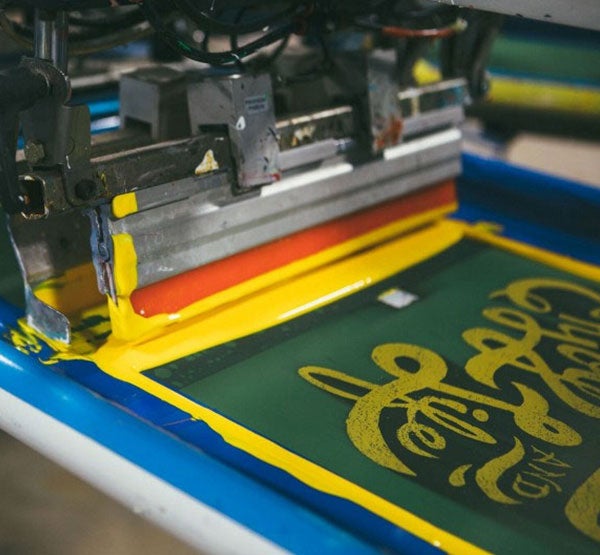High-Quality Custom Screen Printing for Team Apparel
Wiki Article
Screen Printing Uncovered: Whatever You Required to Know Concerning Tee and Garment Printing Methods
Display printing is an interesting approach that combines art with strategy, offering unlimited opportunities for creative thinking. All set to check out the essential components that make display publishing an art type?
The Basics of Screen Printing: How It Works
When you dive into screen printing, you'll uncover it's both a scientific research and an art. At its core, screen printing entails creating a pattern, or screen, that permits ink to go through only in specific locations (screen printing kit). You start by selecting your layout and preparing your screen with a light-sensitive solution. When you reveal this emulsion to light, it sets, leaving your design as an adverse area.Following, you'll mix your inks and prepare your printing surface. Position the display over the material, after that use a squeegee to push ink via the display onto the garment. This procedure needs accuracy, as you want clear, vibrant prints. After printing, you'll cure the ink with warm, guaranteeing it sticks to the textile and lasts through cleans. Each step is important, and grasping them will certainly elevate your display printing abilities, changing easy garments right into unique, meaningful items.
Kinds Of Screen Printing Methods
As soon as you realize the basics of screen printing, it's time to check out the numerous strategies that can elevate your styles. One popular technique is conventional screen printing, where ink is pushed with a stenciled display.Another option is plastisol printing, known for its durability and vibrant shades, making it a favored for lots of brand names. Experiment with halftone printing to create slope effects and detailed layouts.
Important Devices for Display Printing
To accomplish spectacular cause display printing, having the appropriate devices is basic. You'll require a sturdy screen printing structure, which holds the mesh that moves your design onto the garment. Next off, purchase premium squeegees; these are essential for applying ink uniformly throughout the display. You'll additionally require an excellent direct exposure system to create your displays, as well as a washout booth for cleansing them after use. A trusted warmth source, like a conveyor clothes dryer or warm press, is critical for healing your prints to guarantee durability. Don't forget an appropriate work area, geared up with tables and storage for your materials. Lastly, protective gear, such as masks and handwear covers, will keep you secure from chemicals and inks. With the right devices, you'll be well on your method to creating professional-quality prints.Choosing the Right Inks and Products
When picking inks and products for display printing, you require to take into consideration the sort of ink that functions best for your task. Consider textile compatibility to assure your layouts look last and great lengthy. Check out environment-friendly ink options to make your printing procedure much more sustainable.Kinds of Screen Inks
Picking the ideal display ink is crucial for attaining lively, resilient prints that fulfill your project's needs. There are numerous sorts of display inks to check out. Plastisol ink is popular for its convenience and convenience of use, offering excellent color opacity on dark fabrics. Water-based ink, on the various other hand, supplies a softer feeling and is environmentally friendly, making it suitable for those looking to minimize their environmental impact. Release inks get rid of dye from the textile, leading to a soft, classic look yet call for particular handling. Specialized inks, such as glow-in-the-dark or metallic, can include special impacts to your designs. Assess your task requirements and select the ink that straightens best with your preferred end result.
Fabric Compatibility Considerations
Comprehending material compatibility is vital for achieving high-grade screen prints, specifically because various products respond distinctively to different inks. Always examine your inks on example fabric to assure they stick correctly and maintain color honesty. In addition, keep in mind that material weight and appearance can influence the last result, so picking the appropriate ink and product combo is crucial for your project's success.Eco-Friendly Ink Options
Eco-friendly inks are coming to be a preferred option for display printers who want to minimize their ecological effect while preserving high quality. When choosing inks, consider water-based inks, which are much less unsafe and much easier to cleanse up compared to standard solvents.Furthermore, look for inks made from eco-friendly resources, such as soy or vegetable-based options. By selecting the appropriate inks and materials, you'll not just develop sensational layouts yet additionally add to a more lasting printing process. Make the button, and your prints will show your commitment to the atmosphere!
Preparing Your Layout for Screen Printing

File Format Requirements
To ensure your layout looks sharp and vibrant on fabric, you'll require to pay close focus to file style demands for display printing. Make certain your style has a transparent background to prevent unwanted white sides on your prints. Maintain shade modes in mind; CMYK is conventional for display printing, so transform your RGB makes appropriately.Color Splitting Up Techniques
Color splitting up is an important action in preparing your design for display printing, and mastering it can considerably enhance your print high quality. You'll require to break your design right into specific colors, as each color calls for a different display during printing. Begin by determining all the shades in your design and create layers each. You can make use of software like Adobe Photoshop or Illustrator to separate and different shades successfully. Be specific to save each layer as a separate file, commonly in a format like TIFF or PSD. This accuracy not just ensures accurate color representation but also improves the printing procedure. By focusing on shade separation, you'll achieve vibrant and expert cause your screen-printed garments.Resolution and Size
Achieving the very best cause screen printing begins with assuring your style has the appropriate resolution and dimension. Preferably, your art work needs to be at least 300 DPI (dots per inch) for sharp, clear prints. Your final item might look less than professional and pixelated. if you make use of lower resolution.When it pertains to size, consider the measurements of your print location. Layout your art work to match the last print size, ideally creating it in the https://10-9design.com/ actual measurements you'll be printing. In this manner, you'll stay clear of any type of unexpected scaling concerns.
Always examine your design in both vector and raster styles. Vector graphics can be scaled without losing quality, making them ideal for display printing. Preparing appropriately will assure your design looks amazing on every garment!
Step-by-Step Display Printing Process
Display printing is a vibrant procedure that allows you to produce vivid designs on various surfaces. To obtain started, you'll need a screen, solution, and your selected ink.Put ink onto the screen and make use of a squeegee to push the ink with the stencil onto the textile. Raise the display carefully and allow the print completely dry. You've efficiently screen printed your layout.
Tips for Successful Display Printing Projects
While you're diving right into your display printing projects, keep in mind that preparation is vital to success. Beginning by gathering all your materials-- inks, squeegees, garments, and displays. A clean work area aids avoid undesirable errors, so neat up before you begin.Next, verify your artwork is high-resolution and effectively sized for your garment. Test your screen for appropriate direct exposure and clean it completely to avoid smudges. When blending your inks, adhere to the maker's guidelines to attain the ideal uniformity.
During printing, apply even stress with your squeegee for regular results. Do not rush; take your time to validate each print fulfills your requirements. After printing, let your garments dry completely before managing or packaging them.
Finally, constantly maintain a sample of your benefit future reference. In this manner, you can examine your progression and improve your methods in time. Delighted printing!

Often Asked Questions
How Long Does It Take to Set up a Screen Printing Job?
Establishing a screen printing job typically takes about half an hour to an hour. You'll prepare the screens, mix inks, and change journalism. The moment varies based on complexity and experience, so remain arranged!Can I Print on Various Textile Keys In Using the Very Same Technique?
Yes, you can publish on different material kinds making use of the same strategy, yet you'll need to readjust your inks and setups. Some textiles soak up ink differently, so trying out warranties the most effective results for every product.What Prevail Blunders to Prevent in Display Printing?
When screen printing, prevent typical blunders like making use of the wrong ink, overlooking proper direct exposure times, or avoiding pre-press checks. Constantly examine your configuration and keep clean displays to assure quality results each time.How Can I Correctly Tidy and Preserve My Screen Printing Equipment?
To effectively clean and maintain your display printing tools, you must regularly wash displays with proper solvents, examine mops for wear, and assure all devices are stored completely dry and dust-free. Consistency enhances and avoids expensive repair services performance.Is Screen Printing Ecologically Friendly Contrasted to Other Techniques?
Screen printing can be a lot more eco-friendly than other methods, especially if you make use of eco-conscious products and water-based inks. By picking sustainable materials and practices, you reduce waste and minimize your effect on the earth.Display Printing Uncovered: Everything You Need to Know Concerning Tee and Garment Printing Techniques
At its core, screen printing entails developing a stencil, or screen, that allows ink to pass via only in details locations. Position the screen over the material, then use a squeegee to press ink with the display onto the garment. One preferred method is standard display printing, where ink is pressed through a stenciled display.When selecting inks and products for display printing, you need to take into account the type of ink that functions finest for your job.
Report this wiki page